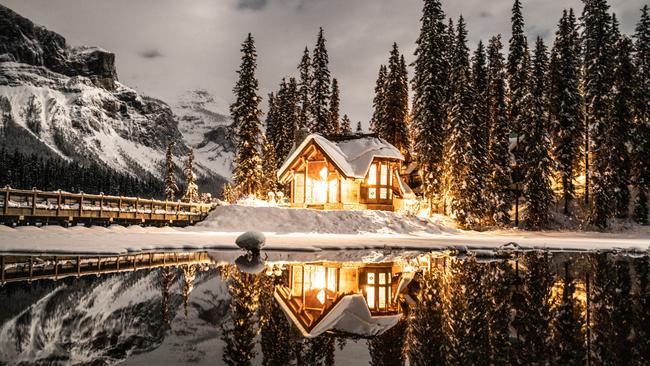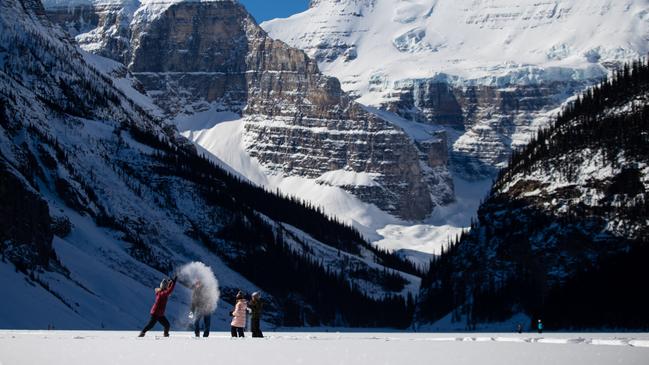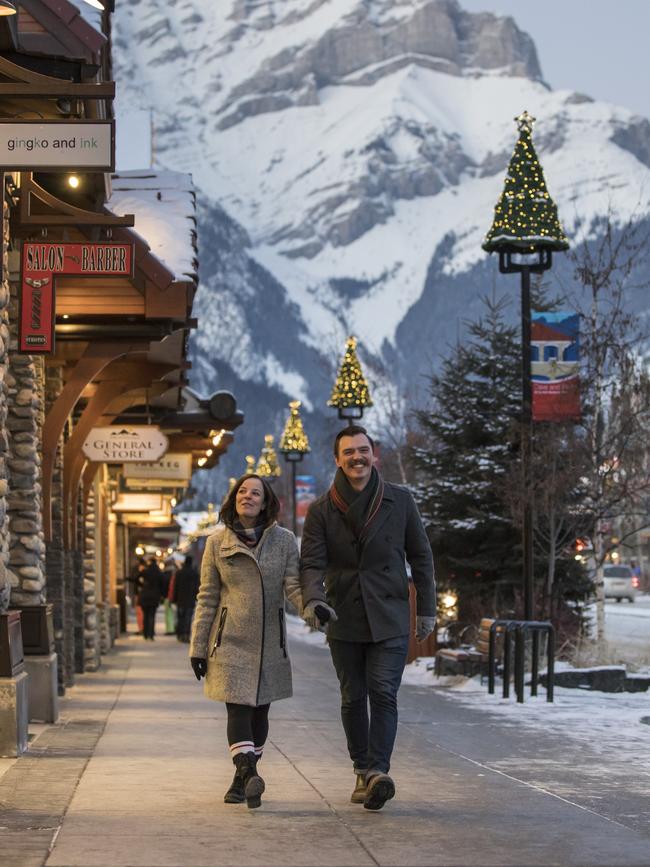Travel Canada in winter for skiing, cabins and canyons
There are rich rewards for those who brave Canada’s snowy highways and byways.

It’s winter in Alberta, in the heart of Canada’s Rocky Mountains, and a frozen waterfall is suspended over a limestone chasm in Johnston Canyon. The double meaning of the word “frozen” has never been so potently embodied as it is right now. But the blue-tinged ice is actually a translucent curtain, with running water gushing behind, like a detuned television trying to pick up a signal, with white noise to match.
The contrast of movement behind the motionless ice is spellbinding. At a pool at the bottom, the flowing water bubbles so vigorously you could almost mistake it for a hot tub, if it wasn’t so obviously the complete opposite. How a flowing waterfall freezes mid-stream I can only put down to wizardry, or possibly the more complex thermodynamic explanation given by our Discover Banff Tours guide, Tim, which I would have jotted down had my hands not been inside two pairs of gloves within the pockets of a goose-down jacket. When it’s minus 20C, the supernatural will suffice.

I’m playing a constant cat and mouse game with the cold during this road trip through the Canadian Rocky Mountain Parks UNESCO World Heritage site. It’s a wonderland of mountains, glaciers, lakes, canyons, and yes, even hot springs. Under its winter coat the landscape is so transfixing it’s hard to believe this is the off season.
Summer here is so popular no one bothers promoting it. But far fewer make the journey in winter. Fewer still consider driving, perhaps put off by the thought of icy roads, snow storms or breakdowns far from civilisation. But the hire car I pick up in Calgary looks sturdy enough, fitted with snow tyres (confidence boosting), a small shovel (confidence denting) and most importantly a good heater.
Tourism in the Rockies was initially developed to help pay for the Canadian Pacific Railway (CPR), a mammoth, transcontinental line that opened in 1885. Tourists were initially wooed by grand hotels such as the Banff Springs Hotel and Chateau Lake Louise (now both part of the Fairmont stable and still setting the bar for luxury), but by the 1920s a new breed of traveller was seeking a more immersive, wilderness-focused experience, ensconced in the landscape rather than sheltered from it, and the log cabin era was born.

Storm Mountain Lodge, 20 minutes’ drive up the Bow Valley from Banff, began life as one of eight “bungalow camps” built in 1922 by workers on the CPR. I arrive at dusk, testing my snow tyres on the steep driveway that leads to the central lodge. Inside, leather lounges are radiating heat from a crackling wood fire. Bear skins, skis and snowshoes hang on dark timber walls. A chandelier of antlers hovers above a rustic bar, and a shaggy bison head watches passively over proceedings from its mount above a river stone fireplace. Take this template and repeat it across every log shack in the Rockies.
READ MORE:Hit the highways if you dare | The wolfdog sanctuary saving hybrid canines | High-altitude town with something for everyone | Vancouver Island’s luxury camp | Best things to do in Jasper
The cabins were restored in 2003 to replicate the character of the ’20s bungalows, and weather-proofed to allow the business to open in winter. My tiny cabin is set in shadowy woods and has a raging fire, a basic bathroom and a fairytale bed carved from sawn timber. Forget television, refrigerators or anything else you wouldn’t find in a Brothers Grimm story. I sit on a couch and read by firelight as snow floats down and piles on the porch.
The town of Banff sprang to life (literally) in 1883, with the discovery of thermal springs on what is now called Sulphur Mountain. To avoid land disputes, the Canadian government set aside 26sq km as the Banff Hot Springs Reserve, which four years later became Banff National Park, the country’s first protected area.


From day one mountains have shaped the town. When the streets were laid out, Banff Avenue was aligned to face Cascade Mountain, and a postcard was born. Hiking the mountain doesn’t appeal in winter, but luckily there’s another way to get a view. I board Banff Gondola, which whisks me 1200 vertical metres to the summit of Sulphur Mountain. If you told me the six ranges that surround me were actually higher than the Himalayas, I’d probably believe you. They owe their epic appearance to gouging from glaciers, carving U-shaped valleys and chiselling knife-edge ridgelines.
The altitude has intensified the cold. Thinking I can tough it out, I resolve to take a short walk along a boardwalk to a cosmic ray station used by geophysicists until 1978, only to be met by a ferocious blast of icy wind as I leave the lee side of the mountain. But what a view. Ignoring the wind chill, I yank off my gloves to snap a photo with my phone.
Bad idea. My phone battery goes instantly flat in the cold, and my hands are stung so fiercely they throb in shock. I abandon my mission and scamper back to the warmth of the summit restaurant, and have to resort to Google to find out more about cosmic ray stations.

Guests lucky enough to snare a window seat at Sulphur Mountain’s Sky Bistro are treated to a sunset for the ages, while out in the Discovery Centre a projection and soundscape installation called Nightrise tells the stories of the Stoney Nakoda Nation, who were once banned from national parks, but have now been welcomed back to play a role in managing the land and sharing their deep knowledge. Next morning I do something you’d be a fool to attempt in summer: drive to Lake Louise. The high-season crowds can be unbearable at this most stunning of the region’s glacier-fed lakes, and the roads clogged with visitors swarming to launch canoes into the turquoise water, and hike the surrounding trails.
It’s a different story today. I find a park with ease and board a horse-drawn sleigh for a ride round the frozen lake as kids play ice hockey in front of the grand chateau, and couples wearing snowshoes stroll hand-in-hand across the shimmering ice.
My second log cabin, Baker Creek by Basecamp, has a family holiday park vibe, with free ice skates and “fat tyre” bike hire. Compared with Storm Mountain Lodge, my cabin has a smorgasbord of amenities, including a record player, with a stack of vinyl to flick through (I’m deflated to find some fiend has swiped Neil Young’s Gold Rush). The woodfire combusts at first sign of a match, and my queen bed is a toasty haven.

Lake Louise Ski Resort is just 15 minutes up the Bow Valley Parkway, part of the Ski-Big3 stable (the other two are Banff Sunshine and Mount Norquay). I meet up on the slopes with my friend Jess, who moved from New Zealand to the Canadian Rockies to work as a ski instructor, and ask her why she chose here. She waves an arm across the valley to the smooth, white pearl of Lake Louise cupped in an unbroken vista of mountains and glaciers, and simply says, “This …”
When a landscape trumps New Zealand’s Southern Alps, you know it’s pretty special.
I make a brief detour into British Columbia, driving alongside a 4km-long freight train as it eases itself down the dangerously steep Big Hill, and into a series of spiralling tunnels. Accessible only by car, Emerald Lake is ringed by deep, green forest, and the ice-encrusted peaks of the President Range. It’s a serene, low-key version of Lake Louise, offering complete solitude. Perched on a peninsula jutting into the lake, Emerald Lake Lodge was rebuilt in the 1980s and, by the looks of my room, hasn’t been touched since. But the central lodge and restaurant has charm, with an elegant oak bar and a smart, modern alpine menu with generous cuts of elk, buffalo, duck breast and Skuna Bay salmon.

Out on the lake I strap on cross-country skis and follow pre-cut tracks to an open, montane glade on the far side of the lake, dotted with pine trees and flanked by mountains. For a surreal moment it feels like I’m living inside a model railway set, gliding through a landscape so enchanting it could be ordered from a catalogue. Incredibly, there’s no one else here.
Near empty also is the 232km Icefields Parkway, which links Lake Louise with Jasper, spanning the Continental Divide and following the geographic contours of an Indigenous hunting route. More than 100 glaciers line the drive, vying for attention with lakes, waterfalls and the stupendous Columbia Icefield, site of the supremely accessible Athabasca Glacier, which once flowed to the road, but is now in alarming retreat, shrinking by 5m a year. See it while you can.
I arrive in Jasper with time to tour the caves and crevasses of Maligne Canyon with Sundog Tours. Ice climbers scale 50m high frozen waterfalls while we explore the karst landscape at ground level, peeking behind the curtains of icicles that hang like the solidified drippings of candle wax.

Jasper began life as a fur trading outpost, but these days is known as the cabin capital of the Rockies, so I have high hopes when I check into Pyramid Lake Resort. While I’ve learnt not to expect luxury, the sprawl of bygone era motel rooms feels like it’s given up trying to impress. The only drinking vessels in my room are the type of plastic cups dentists give you to spit into, and the wiring is so bad I get an electric shock when I flick a light switch.
But then I look out the window and see an island of snow-capped pine trees in the middle of a shockingly white lake, with insane mountains rising behind, crystalline against the fading purple sky, setting itself for a midnight screening of the Northern Lights, and I’m reminded once more that here in the Rockies it’s what’s on the outside that counts.
Ricky French was a guest of Destination Canada, Banff Lake Louise Tourism, Destination British Columbia and Tourism Jasper.
IN THE KNOW
Banff is 90 minutes’ drive from Calgary, with Lake Louise a further 40 minutes away. Storm Mountain Lodge has cabins from $C369 ($406) a night, Baker Creek by Basecamp from $C344, Emerald Lake Lodge from $C160, Pyramid Lake Resort from $C230.

To join the conversation, please log in. Don't have an account? Register
Join the conversation, you are commenting as Logout